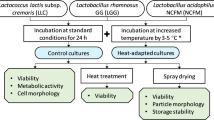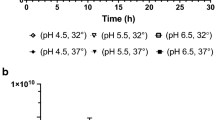Abstract
We have studied the potential of environmental adaptation as a survival mechanism to enable lactic acid bacteria to withstand spray drying. The formulation process of these bacteria exposes them to stresses such as heating and dehydration on daily basis. In the present study, the effect of heat adaptation on subsequent exposure of Lactobacillus lactis subsp. lactis HE-1 cells to various types of lethal stress was examined by comparing the viability of heat-adapted cells with nonadapted ones. The responses of heat-adapted cells to other environmental stresses such as H2O2, heat, acid, and ethanol were also examined. The results showed that heat-adapted cells had a higher survival rate than the non-adapted cells. Morphological analysis was performed to explain the observed differences. The adaptation mechanisms in response to stresses in L. lactis subsp. lactis HE-1 are to be fundamental for survival during spray drying process.
Similar content being viewed by others
References
Porubcan RS, Sellars RL. Lactic starter concentrates. pp. 59–92. In: Microbial Technology. Peppler HJ, Perlman D (eds). Academic Press, Waltham, MA, USA (1979)
Sandine WE. Commercial production of dairy starter cultures. pp. 191–206. In: Dairy Starter Cultures. Cogan TM, Accolas JP (eds). John Wiley & Sons, Inc., Hoboken, NJ, USA (1996)
Van de Guchte M, Serror P, Chervaux C, Smokvins T, Ehrlich SD, Maguin E. Stress response in lactic acid bacteria. Anton. Leeuw. J. Microb. 82: 187–216 (2002)
De Angelis M, Gobbetti M. Environmental stress responses in Lactobacillus: A review. Proteomics 4: 106–122 (2004)
Stanton C, Desmond C, Coakley M, Collins JK, Fitzgerald G, Ross RP. Challenges facing development of probiotic-containing functional foods. pp. 27–58. In: Probiotics and Health. Farnworth E (ed). CRC Press, Inc., Boca Raton, FL, USA (2003)
Prasad J, McJarrow P, Gopal P. Heat and osmotic stress responses of probiotic Lactobacillus rhamnosus HN001 (DR20) in relation to viability after drying. Appl. Environ. Microb. 69: 917–925 (2003)
Hartke A, Bouche S, Gansel X, Boutibonnes P, Auffray Y. Starvation-induced stress resistance in Lactococcus lactis subsp. lactis IL1403. Appl. Environ. Microb. 60: 3474–3478 (1994)
Jenkins DE, Chaisson SA, Matin A. Starvation-induced cross protection against osmotic challenge in Escherichia coli. J. Bacteriol. 172: 2779–2781 (1990)
Rallu F, Gruss A, Ehrlich SD, Maguin E. Acid- and multistress-resistant mutants of Lactococcus lactis: Identification of intracellular stress signals. Mol. Microbiol. 35: 517–528 (2000)
Schieifer KH, Kraus J, Dvorak C, Kilpper-Balz R, Collins MD, Fischer W. Transfer of Streptococcus lactis and related Streptococci to the genus Lactococcus gen. nov. Syst. Appl. Environ. Microb. 6: 183–195 (1985)
Whitaker RD, Batt CA. Characterization of the heat shock response in Lactococcus lactis subsp. lactis. Appl. Environ. Microb. 57: 1408–1412 (1991)
van Asseldonk M, Simons A, Vissier H, de Vos WM, Simons G. Cloning, nucleotide sequence, and regulatory analysis of the Lactococcus lactis dnaJ gene. J. Bacteriol. 175: 1637–1644 (1993)
Eaton T, Shearman C, Gasson M. Cloning and sequence analysis of the dnaK region of L. lactis subsp, lactis. J. Gen. Microbiol. 139: 3253–3264 (1993)
Kim SG, Batt CA. Cloning and sequencing of the Lactococcus lactis subsp, lactis groESL operon. Gene 127: 121–126 (1993)
Arnau J, Sorensen KI, Appel KF, Vogensen FK, Hammer K. Analysis of heat shock gene expression in Lactococcus lactis MG1363. Microbiology 142: 1685–1691 (1996)
Duwat E, Ehrlich SD, Gruss A. The recA gene of Lactococcus lactis: Characterization and involvement in oxidative and thermal stress. Mol. Microbiol. 17: 1121–1131 (1995)
Boutibonnes E, Gillot B, Auffray Y, Thammavongs B. Heat shock induces thermotolerance and inhibition of lysis in a lysogenic strain of Lactococcus lactis. Int. J. Food Microbiol. 14: 1–9 (1991)
Jeroni D, Brashears MM. Production of H2O2 by Lactobacillus delbruckii subsp. lactis influenced by media used for propagation of cells. J. Food Sci. 65: 1033–1036 (2000)
Achanta G, Huang P. Role of p53 in sensing oxidative DNA damage in response to reactive oxygen species-generating agents. Cancer Res. 64: 6233–6239 (2004)
Lee NK, Kim HW, Chang HI, Yun CW, Kim SW, Kang CW, Paik HD. Probiotic properties of Lactobacillus plantarum NK181 isolated from jeotgal, a Korean fermented food. Food Sci. Biotechnol. 15: 227–231 (2006)
Christiansen P, Nielsen EW, Vogensen FK, Brogren CH, Ardo Y. Heat resistance of Lactobacillus paracasei isolated from semi-hard cheese made of pasteurised milk. Int. Dairy J. 16: 1196–1204 (2006)
Lin J, Matthew P, Smith K, Chapin C, Baik HS, George NB, Foster JW. Mechanisms of acid resistance in enterohemorrhagic Escherichia coli. Appl. Environ. Microb. 62: 3094–3100 (1996)
Rallu F, Gruss A, Maguin E. Lactococcus lactis and stress. Anton. Leeuw. J. Microb. 70: 243–251 (1996)
Hartke A, Bouche S, Giard JC, Benachour A, Boutibonnes P, Auffray Y. The lactic acid stress response of Lactococcus lactis subsp. lactis. Curr. Microbiol. 33: 194–199 (1996)
Kim WS, Ren J, Dunn NW. Differentiation of Lactococcus lactis subspecies lactis and subspecies cremoris strains by their adaptive response to stresses. FEMS Microbiol. Lett. 171: 57–65 (1999)
Author information
Authors and Affiliations
Corresponding author
Rights and permissions
About this article
Cite this article
Kang, CH., Jeon, H., Shin, Y. et al. Heat adaptation improves viability of Lactococcus lactis subsp. lactis HE-1 after heat stress. Food Sci Biotechnol 24, 1823–1827 (2015). https://doi.org/10.1007/s10068-015-0238-1
Received:
Revised:
Accepted:
Published:
Issue Date:
DOI: https://doi.org/10.1007/s10068-015-0238-1




